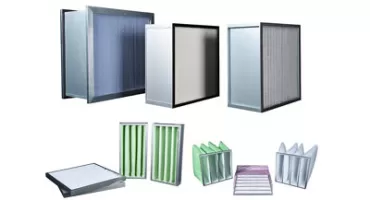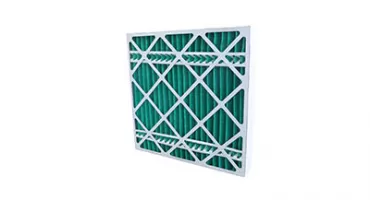 November 05, 2024
November 05, 2024
Gas turbine power plants play a crucial role in providing electricity worldwide, relying on gas turbines to produce large amounts of energy quickly. However, gas turbines are also highly sensitive to environmental contaminants, and their performance can be significantly impacted by impurities in the air. This is where air filtration becomes vital, ensuring that only clean air reaches the turbine, which in turn maintains efficiency, minimizes maintenance costs, and prolongs the operational life of the plant.
In this blog post, we’ll explore the importance of air filtration in gas turbine power plants, discuss the types of filters available, and examine the key considerations for optimizing filtration to keep turbines running efficiently.
Gas turbines require vast amounts of air to operate, drawing in thousands of cubic meters per second. Since these plants often operate in various climates and environments, they’re exposed to airborne contaminants, including dust, sand, salt, moisture, and other industrial pollutants. Even small particles can impact the turbines, causing wear and tear, reducing efficiency, and increasing fuel consumption.
Here are the main reasons why effective air filtration is critical in gas turbine power plants:
1. Improved Efficiency: Contaminants in the air can erode turbine blades, reduce aerodynamic efficiency, and clog essential components. Clean air ensures the turbine operates at peak efficiency.
2. Extended Component Lifespan: Airborne particles can damage the turbine blades, rotors, and other internal components, resulting in more frequent maintenance or replacement. Proper filtration protects these components, prolonging their lifespan.
3. Lower Maintenance Costs: With fewer contaminants entering the turbine, maintenance intervals can be extended, and the overall cost of keeping the turbine running is reduced.
4. Enhanced Reliability and Availability: Downtime for maintenance or repair due to contaminated turbines can lead to unexpected costs and reduce the availability of the power plant. Effective filtration minimizes these interruptions.
5. Reduced Environmental Impact: Cleaner turbines operate more efficiently, which reduces fuel consumption and minimizes emissions.
Choosing the right air filtration system is essential for achieving optimal turbine performance. There are several types of filters that can be used depending on environmental conditions, the turbine model, and the plant’s operational priorities.
1. Pre-Filters
Pre-filters are the first line of defense against large airborne particles, such as dust and sand. These filters help remove larger contaminants before they reach the more sensitive parts of the system. Pre-filters can be made from various materials, such as synthetic fibers, and typically have a lower filtration efficiency than final filters. They are crucial for preventing premature clogging of downstream filters, which can increase the overall efficiency of the filtration system.
Final filters are designed to capture smaller particles that pass through the pre-filters. These filters often use HEPA (High-Efficiency Particulate Air) technology, which can capture 99.97% of particles as small as 0.3 microns. In gas turbine applications, final filters help ensure that even fine dust, salt particles, and other microscopic contaminants are removed from the intake air, protecting the turbine blades and other components.
3. EPA and HEPA Filters
EPA (Efficient Particulate Air) and HEPA filters are commonly used for applications where high efficiency is required. These filters are particularly beneficial in harsh environments, such as coastal or desert areas, where fine particles are abundant. They can significantly improve turbine performance by minimizing blade fouling and reducing erosion rates.
4. Pulse Filter Systems
Pulse filter systems are designed to operate in dusty environments where filter clogging is a major concern. These systems use compressed air pulses to clear out accumulated dust on the filters, which extends their lifespan and keeps air intake pressure consistent. Pulse filters are especially valuable in industrial or arid locations where large amounts of dust and dirt particles are present in the air.
5. Self-Cleaning Filters
Self-cleaning filters are advanced systems that allow continuous operation without frequent filter replacement. They automatically remove collected dust and debris, which can be particularly beneficial for gas turbines in remote locations or those requiring constant availability.
Selecting the right air filtration system for a gas turbine power plant is not a one-size-fits-all process. Several factors should be considered to ensure that the filtration solution meets the specific needs of the plant:
1. Environmental Conditions
The local environment plays a significant role in determining the type of air filter needed. For example, turbines located near the coast may require filters that can handle salt particles, while those in desert environments need systems that effectively remove sand and dust.
2. Filtration Efficiency
Higher-efficiency filters, such as HEPA filters, capture smaller particles but may also increase the resistance to airflow. Balancing efficiency with the operational needs of the turbine is critical to avoid increased energy consumption due to high resistance.
3. Operational Costs
Air filters require maintenance and replacement, and choosing the wrong type can result in higher costs. While high-efficiency filters may have a higher upfront cost, they can reduce maintenance frequency and improve turbine performance, leading to overall cost savings.
4. Airflow and Pressure Drop
Turbines require a constant airflow to operate effectively. Filters with a high pressure drop can restrict airflow, which affects turbine performance and fuel efficiency. Filter systems should be selected with minimal pressure drop to ensure optimal performance.
5. Maintenance and Replacement Intervals
Some filters require frequent replacement, while others are designed for longer life spans with minimal maintenance. The maintenance needs of the plant and the accessibility of the filter system should be considered when selecting a filtration solution.
To ensure the ongoing effectiveness of air filtration systems, regular maintenance is essential. Here are some best practices for keeping air filters in peak condition:
1. Regular Inspections
Regular inspections help identify issues such as filter clogging, wear, and damage. Early detection can prevent severe impacts on turbine performance.
2. Scheduled Filter Replacement
Each type of filter has a recommended replacement interval based on its material, efficiency, and environmental exposure. Replacing filters on schedule prevents performance dips and protects turbine components.
3. Monitoring Differential Pressure
Monitoring the differential pressure across filters can provide insights into their condition. A rising pressure drop often indicates clogging or reduced airflow, signaling that it may be time for maintenance or replacement.
4. Cleaning or Replacing Pre-Filters
Pre-filters typically accumulate dust and dirt more quickly than final filters. Cleaning or replacing pre-filters regularly helps protect downstream filters and extends the lifespan of the filtration system.
5. Adapting Filtration Based on Seasonal Changes
In areas with seasonal weather variations, different types of filters may be needed at different times of the year. For example, areas with heavy pollen seasons might require more frequent filter changes or higher-efficiency filters during peak pollen periods.
Several gas turbine power plants have achieved enhanced performance and cost savings by implementing the right air filtration solutions. Here are two examples:
1. Coastal Power Plant in the Middle East
A gas turbine power plant located near the coast in the Middle East faced challenges with salt particles entering the turbine. The plant implemented a filtration system with EPA filters specifically designed to capture salt and fine dust particles. As a result, the turbine showed improved efficiency, reduced corrosion, and required less frequent maintenance.
2. Desert-Based Power Plant in North Africa
A power plant located in a desert region of North Africa struggled with dust and sand clogging the turbine intake. By installing pulse filters with self-cleaning capabilities, the plant managed to keep air intake pressure stable, reducing the frequency of maintenance and extending the lifespan of the turbine components.
Air filtration is a fundamental aspect of maintaining gas turbine power plants, as it directly impacts turbine efficiency, operational costs, and component longevity. By choosing the right filtration system and following best practices for maintenance, power plant operators can enhance their turbines' reliability, reduce environmental impact, and save on long-term operational costs.
The key to effective air filtration in gas turbine power plants is understanding the specific needs of each plant, selecting filters that are suited to the local environment, and investing in regular maintenance. With the right approach, power plants can ensure cleaner, more efficient turbine operation for years to come.
 Nov. 20, 2023
The Application of Air Filters in Cleanrooms
Nov. 20, 2023
The Application of Air Filters in Cleanrooms
 Jun. 13, 2023
Enhancing Indoor Air Quality with Ventilation Air Filters
Jun. 13, 2023
Enhancing Indoor Air Quality with Ventilation Air Filters
 Mar. 18, 2024
Why Do I Need a HEPA Filter?
Mar. 18, 2024
Why Do I Need a HEPA Filter?

